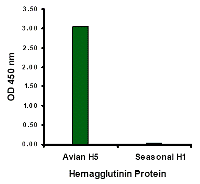Product Detail
Product NameHemagglutinin Monoclonal Antibody
Clone No.mAb (Clone 4F1F2)
Host SpeciesMouse
ClonalityMonoclonal
PurificationImmunoaffinity chromotography purified IgG
ApplicationsELISA
Species ReactivityVirus
Immunogen TypePeptide
Immunogen DescA peptide corresponding to synthetic peptide corresponding to 14 amino acids in the middle of Hemagglutinin.
Target NameHemagglutinin
ConjugateUnconjugated
Other NamesAvian Influenza A (H5N1) Hemagglutinin (4F1F2), H5N1 Hemagglutinin
Accession NoSwiss-Prot:Q692M2
Gene ID:
Uniprot
Q692M2
Concentration1mg/ml
FormulationSupplied in PBS containing 0.02% sodium azide.
StorageCan be stored at -20˚C, stable for one year.
Application Details
Hemagglutinin antibody at 2 ug/mL specifically recognizes Avian H5N1 influenza virus but not seasonal influenza virus A H1N1 Hemagglutinin protein.
Influenza A virus is a major public health threat, killing more than 30,000 people per year in the USA. Novel influenza virus strains caused by genetic drift and viral recombination emerge periodically to which humans have little or no immunity, resulting in devastating pandemics. Influenza A can exist in a variety of animals; however it is in birds that all subtypes can be found. These subtypes are classified based on the combination of the virus coat glycoproteins hemagglutinin (HA) and neuraminidase (NA) subtypes. During 1997, an H5N1 avian influenza virus was determined to be the cause of death in 6 of 18 infected patients in Hong Kong. The more recent virulent strain of H5N1 is now seen in Africa and Europe, as well as in southeast Asia. There is some evidence of human to human spread of this virus, but it is thought that the transmission efficiency was fairly low. HA interacts with cell surface proteins containing oligosaccharides with terminal sialyl residues. Virus isolated from a human infected with the H5N1 strain in 1997 could bind to oligosaccharides from human as well as avian sources, indicating its species-jumping ability. While efforts were made to use relatively conserved regions of the viral sequence as the antigen, the influenza virus genome has drifted somewhat from what was first reported. However, this antibody was able to recognize peptides derrived from viruses from Indonesian human patients infected in 2007.
If you have published an article using product 26005, please notify us so that we can cite your literature.



 Yes
Yes



